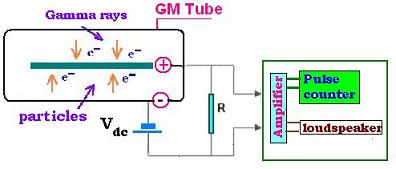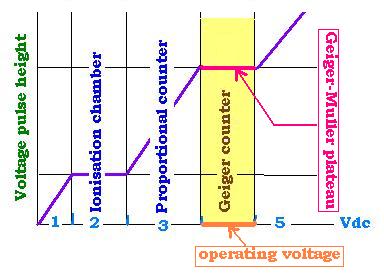Contents
© The scientific sentence. 2010
| Geiger Muller counter
1. Description:
The Geiger Müller Counter is used for measurements in nuclear decay.
It consists of a cylindrical metal tube (GM tube) with a thin mica
end window. The cylinder is filled with a certain type of gas. It
contains a long wire at the center kept at a high positive voltage,
that is a positive electrode (cathode). The negative electrode is
wall of the cylinder. The ion and electron generated are calle
ion pairs.
When a gamma ray enters the detector, It ionizes the atoms of the gas;
that is it extracts the electrons from the atoms, and forethermor, gas
ions are produced. The electrons are accelerated (due to the supply of
high applied voltage Vdc between the electrodes) towards the center wire,
and the produced ions towards the outer wall. These ions are charged
and becomes again charged atoms ready for the next discharge.
These extracted electrons leave the GM tube, flow through the resistor R
and constitute an electric current I, and generate a voltage V=RI
(Ohm's law) across this resistor.
 This voltage (the voltage pulse) is amplified and used to the measurement.
Commonly, the used device is a loudspeaker that gives an audible click
for a generated pulse.
The Geiger Muller counter operates within a specific region of
the applied voltage, generally between 300 qnd 400 volts.
This voltage (the voltage pulse) is amplified and used to the measurement.
Commonly, the used device is a loudspeaker that gives an audible click
for a generated pulse.
The Geiger Muller counter operates within a specific region of
the applied voltage, generally between 300 qnd 400 volts.
2. Operating region for a GM tube:
The collected voltage pulse height increases as the Vdc
voltage increases, then the recombination of positive ions and
electrons reduces. The progression of the applied voltage Vdc is
as follows:
- 1. At first, Vdc1 is relatively low so that recombinations occur. As
a result, not all ion pairs are collected.
- 2. Vdc2 is sufficiently high, so that only a negligible amount of
recombinations occur. In this region, operate the detectors called
Ionisation Chamber.
- 3. Vdc3 becomes sufficiently high, so that electrons approach the
centre wire and gain sufficient energy between collisions with the
electrons of gas atoms, and produce new ion pairs. Thus the number of
electrons becomes important and the electric charges leave the GM tube
and pass through the resistor R. Vdc3 is up to a thousand times
greater than the charge produced initially by the radiation interaction.
In this region operate the detectors called the Proportional Counter .
-4 Vdc4 becomes so high that even a one ionising particle will
produce a very large voltage pulse. The initial ionisation produced
by the radiation triggers a complete gas breakdown as an avalanche
of electrons moving towards the centre wire.
In this region, called Geiger-Müller region, operates the
radiation detector Geiger counter.
-5 Finally, Vdc5 is high enough for the gas to completely breakdown
and it cannot be used to detect any radiation.
 The inert gas inside the cylinder of the GM tube acts as an amplifier
of the electric charges produced. To prevent the related avalanche,
the gas must be quenched by adding an amount of another gas like
ethyl alcool for argon. Even a quenching is used, the detector is
insensitive for a small period of time following absorption of a
radiation; the time the ions becomes charged. This period of time is
called the Dead Time wchich is relatively short (200-400 ms).
In the operating voltage of 100 volts (between 300 and 400) volts region,
the Geiger counter is not dependent of the voltage change, therefore,
sensitive amplifier is not needed and makes the radiation detector GM
simple to use.
The inert gas inside the cylinder of the GM tube acts as an amplifier
of the electric charges produced. To prevent the related avalanche,
the gas must be quenched by adding an amount of another gas like
ethyl alcool for argon. Even a quenching is used, the detector is
insensitive for a small period of time following absorption of a
radiation; the time the ions becomes charged. This period of time is
called the Dead Time wchich is relatively short (200-400 ms).
In the operating voltage of 100 volts (between 300 and 400) volts region,
the Geiger counter is not dependent of the voltage change, therefore,
sensitive amplifier is not needed and makes the radiation detector GM
simple to use.
|
|